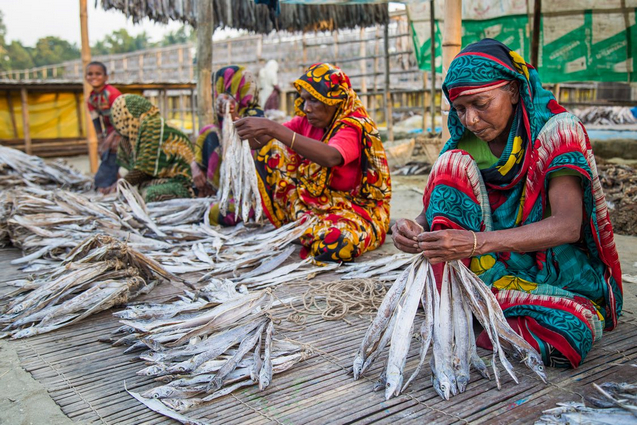From incessant rains to flooded rice fields, the economic impact of global warming has been keenly felt in the coastal town of Cox’s Bazar
 |
| Women work at a dry fish yard in the Bangladeshi coastal resort of Cox’s Bazar. Changing weather conditions have hit the business hard. Photograph: Noor Alam/Majority World for the Guardian |
But Aman Ullah Shawdagor, a dry fish businessman who employs 70 people, says high tides and seasonal changes have hit his business hard. Last year there were four cyclones, more than ever before. In 2015, there was only one.
“My business is not doing so well because of the changing weather conditions,” says Shawdagor. “This is a dry season business. But for the last couple of years, the rain has become more frequent. It rains not only in the rainy season but also in the winter. There have also been more signals [storm warnings] with the rise in high tides. When the high tide comes, it frequently covers the whole of the land here. It is very bad for the dry fish.”
Nurul Hashem, a schoolteacher from Kutubdia Para, a nearby shanty town where many of the dry fish workers live, has also noted the trend. “We believe the water level is getting higher here,” he says. “Last year, my home was under water three or four times.”
Scientists predict that, by 2050, as many as 25 million people in Bangladesh will be affected by the rising sea level. Hashem and Shawdagor believe that they are already seeing the effects of a changing climate, however.
Kutubdia
Along the coast lies Kutubdia, an island in the Bay of Bengal where lush green rice fields give way to acres and acres of flat fields. Consisting of small rectangles of varying hues of brown, they are salt fields. The encroachment of saline water from rising tides has made rice farming impossible.
Abdus Shukur, 50, a former agricultural farmer, says he learned to farm salt 10 years ago, when sea water flooded the land he rents. It took him six months to learn the craft and he finds it back-breaking work.
“I was an agricultural farmer before,” says Shukur. “But the embankment broke down and saline water came on to the land. We had no choice but to adapt.”
Salt farming, he says, brings in more money that crops. But it is harder.
 |
| Flooded salt fields on the island of Kutubdia. Photograph: Noor Alam/Majority World for the Guardian |
The small island, which has halved in size over the past 20 years due to erosion and sea level rise, is surrounded by a three-metre high concrete embankment, built by the Bangladeshi government to protect it from disappearing into the sea. But it is broken in several places and the sea water enters the land.
“The coastal belt is facing many problems of salinity,” says Mokbul Ahmed, a project co-ordinator for Coast, an organisation that helps local communities affected by the changing climate. “Day by day, salt water enters the land. In Kutubdia, every year, the government builds the embankment and every year, it is destroyed.”
Links
- Climate Change Fallout in Bangladesh: 9.6m people to migrate by 2050
- On the climate change frontline: the disappearing fishing villages of Bangladesh
- Rising seas sweep away land and livelihoods in Bangladesh – in pictures
- Climate finance dispute prompts Bangladesh to return £13m of UK aid
- COP22 host Morocco launches action plan to fight devastating climate change
- Deluge turns to dearth for Bangladesh as age-old water woes take new form
- Bangladesh tackles climate change by fusing rice paddies with fish farms
- The threat posed by climate change in Bangladesh – in pictures
- Why Bangladesh doesn't want climate adaptation loans
- Climate Change: The Potential Impacts Of Collective Inaction
- How Do We Deal With The Prospect Of Increased Climate Migration?
- Climate Change Will Stir 'Unimaginable' Refugee Crisis, Says Military

No comments :
Post a Comment